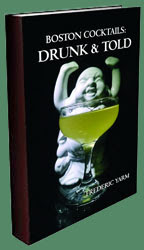 The final talk I attended on Thursday at Tales of the Cocktail was entitled United Libations that explored cross-cultural differences and similarities between three bartending worlds: United States, Latin America (Cuban), and Japan. Representing the three were Charles Joley, Julio Cabrera, and Shuichi Nagatono, respectively; I also had the honor of sitting at moderator Mark Schettler's bar a few nights later at Bar Tonique to see how bartending on a street level craft cocktail dive bar in New Orleans works.
The final talk I attended on Thursday at Tales of the Cocktail was entitled United Libations that explored cross-cultural differences and similarities between three bartending worlds: United States, Latin America (Cuban), and Japan. Representing the three were Charles Joley, Julio Cabrera, and Shuichi Nagatono, respectively; I also had the honor of sitting at moderator Mark Schettler's bar a few nights later at Bar Tonique to see how bartending on a street level craft cocktail dive bar in New Orleans works.The American school of bartending began with Jerry Thomas and Harry Johnson in terms of style. Even early on, there were differences between corner taverns and craft bartenders. Unlike the Latin American and Japanese styles, the American system was interrupted during Prohibition. Later after the dark years, the American bartenders were the ones that led the cocktail renaissance over the last 15 years originating in the speakeasy culture in New York City. The American school is full of different styles all making great drinks, but it is a profession that does not require any apprenticeship. Unlike the other two systems, American bartending is faster to provide the same good drink.

Nagatono described how he has been bartending for 25 years and still considers himself an apprentice, and this helps to preserve the lineage and style. The Japanese bartender's entire career is training and one never stops learning. "Whenever we start a student in Japan, [we tell them] when you are working, you are learning." Since there are many types of bars in Japan, there are many different sets of rules. Many of the Japanese cocktail bars are small with 7-12 seats; while they might not be financially lucrative, they are run with heart and passion by the owner/bartender and perhaps one other staff member. In Japan, the bartender makes one drink at a time for one guest at a time with great concern for technique and ice choice.
 The 2017 collection of 855 drink recipes, bartender tributes, and essays on hospitality from CocktailVirgin's Frederic Yarm. Available at
The 2017 collection of 855 drink recipes, bartender tributes, and essays on hospitality from CocktailVirgin's Frederic Yarm. Available at  The 2012 collection of 505 drink recipes, techniques, and Boston bar recommendations from Frederic Yarm. Available at
The 2012 collection of 505 drink recipes, techniques, and Boston bar recommendations from Frederic Yarm. Available at 




No comments:
Post a Comment